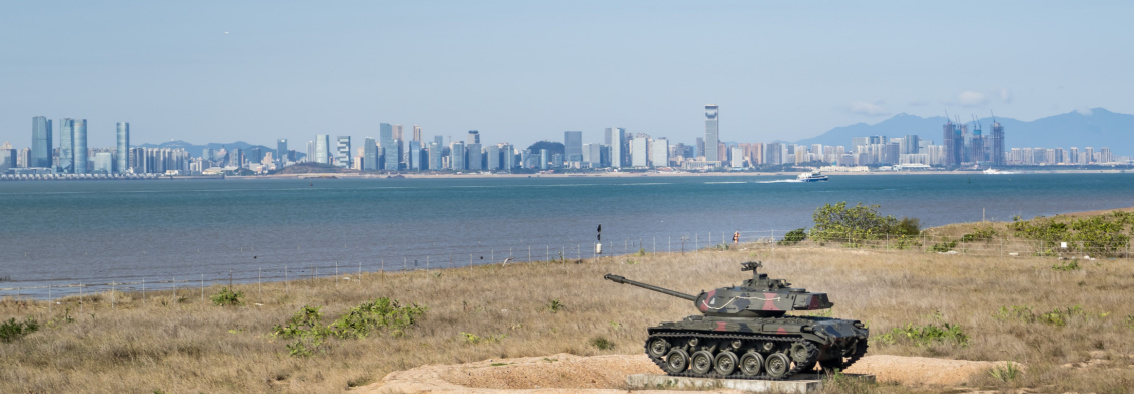The recent inauguration of Taiwan President Lai Ching-te (賴清德) and his speech emphasizing Taiwan’s existence as a “sovereign, independent nation in which sovereignty lies in the hands of the people” (“中華民國臺灣是一個主權獨立的國家、主權在民”) set off a pre-planned coercion operation by the People’s Republic of China (PRC). This operation was centered around the People’s Liberation Army’s (PLA, 中國人民解放軍) 23-24 May Joint Sword-2024A (聯合利劍- 2024A) exercise, advertised as “punishment for Taiwan separatist acts.”
The amount of force used was clearly regulated by the Chinese Communist Party’s (CCP) Central Military Commission (中央軍事委員會) to match their assessment of the political “acceptability” of Lai’s speech. Lai did not mention any of the Party’s favored phrases regarding Taiwan—such as “One Country, Two Systems” (一國兩制), or the “1992 Consensus” (九二共識). However, it is unlikely that the CCP leadership expected this from the leader of the Democratic Progressive Party (DPP, 民進黨), which never agreed to the “1992 Consensus” in the first place. Instead, the CCP was likely anticipating a repeat of Tsai Ing-wen’s (蔡英文) phrase elliptically referencing the 1992 Consensus, “the Republic of China Constitution and the Act Governing Relations Between the People of Taiwan Area and the Mainland Area.” Lai’s omission of this phrase probably constituted the basis for the Party’s post-inaugural propaganda that Lai was sending a “dangerous signal of seeking independence”—even when Lai clearly did not call for revision to the Republic of China Constitution, Taiwan independence, or the rejection of dialogue with the PRC.
Accordingly, the Party’s response was a “medium” coercion operation—with several escalatory “innovations,” particularly with respect to lawfare. A large number of troops were involved, but compared to the 2023 Joint Sword exercise, the length was shorter and the exercise zones were slightly smaller as well. The PLA Rocket Force (PLARF, 解放軍火箭軍) notably did not launch ballistic missiles over Taiwan, as they did following then-House Speaker Pelosi’s visit to Taiwan in August 2022. Instead, the main escalation was through the use of lawfare: the announcement of a concurrent “comprehensive law enforcement exercise” around Wuqiu (烏坵) and Dongyin (東引) islands by the Fujian branch of the China Coast Guard (CCG, 中國人民武裝警察). The PRC tabloid Global Times (環球時報) darkly noted that the CCG might replicate the “Kinmen model” there, referencing the February 2024 CCG boarding and inspection of a Taiwanese tourist boat. This was followed by the PRC publication of guidelines threatening the death penalty for “ringleaders” of Taiwan independence. With the continuation of the pressure campaign against Taiwan, concurrent with a broader push by the PRC to intimidate its other regional neighbors, it is clear that Taiwan needs to be prepared for a heightened level of gray zone warfare and boundary-breaking aggression in the near-future.
In this article, I will look at defense priorities that the new government should focus on to both craft a sustainable strategy to counter gray zone operations, as well as to increase deterrence against an all-out attack.
Wargame Responses to Heightened Gray Zone Warfare
Over the last decade, the PRC has created, resourced, and refined its gray zone strategy. Many of the techniques used against Taiwan to create “new norms” (新常態)—such as the aggressive use of the CCG, as well as the People’s Armed Forces Maritime Militia (PAFMM, 中國海上民兵)—were first tested against Vietnam, Philippines, and Japan. The PRC is now experimenting with a much wider regional and international employment of gray zone operations, as well as even sharper tactics. In December 2023, the CCG used a suspected acoustic weapon against the Philippines in the Scarborough Shoal; at the time of this writing, CCG personnel are now wielding knives and axes against Philippine naval crew in the Second Thomas Shoal, replicating on sea what the PLA has done against the Indian army on land .
Taiwan has already taken a number of steps to counter maritime gray zone coercion. Taiwan’s Coast Guard is expanding in size, while demonstrating the capability to militarize at need by test-firing anti-ship missiles from Coast Guard ships. Taiwan’s Navy is standing up a Littoral Combat Command (立濱海作戰指揮部) to defend Taiwan’s territorial waters, integrating fast-attack boats and anti-ship missile groups. These steps all provide incremental, separate improvements to Taiwan’s capability and capacity to respond to increased incursions. However, just as the PRC has repeatedly tested a whole-of-government gray zone strategy, Taiwan should also integrate its own efforts as part of a national defense strategy.

Image: Taiwan Coast Guard CG-601 Anping (安平) cutter test-firing a Hsiung Feng II (雄風二型) anti-ship missile, May 27, 2022. Frequent Coast Guard/Navy cross-training is critical for demonstrating that Taiwan Coast Guard assets are capable of contesting gray-zone aggression, while complicating adversary targeting during wartime. However, these capabilities need to be broadly fielded and connected to a robust common operating picture to provide credible deterrence. (Source: Wikimedia Commons)
For instance, Taiwan’s current gray zone response is split between two sometimes conflicting political imperatives: demonstrating sovereignty and ensuring non-escalation. While Taiwan’s defense establishment has of late been leaning more towards the first imperative, the PRC’s fielding of escalatory tools such as destructive water cannons, barriers, and acoustic weapons will likely force continued debate over which imperative Taiwan should prioritize.
As a first step, Taiwan should proactively war-game responses to a heightened level of gray zone coercion. These wargames or crisis simulations could be modeled off the multiple games that the US House China Committee conducted in 2023-2024 to educate US politicians and business leaders on how an invasion might develop, as well as to explore potential responses. Accordingly, a Taiwanese version centered on gray zone warfare could include participants such as members of the Legislative Yuan and the Taiwanese business community, and could be run by a Taiwanese think tank with experience in wargaming—such as the Institute for National Defense and Security Research (INDSR, 國防安全研究院). American participants or observers could provide insight into Washington’s interpretations of Taiwanese actions. The goals of the wargame would be to gain a baseline level of bipartisan agreement over responses to aggression, and to understand the opportunity costs that a symmetric response would place on Taiwan’s military. Follow-on games might incorporate civilian ministries as well, “stress-testing” government functions across a variety of coercive scenarios and assisting Taiwan’s leadership in developing a strategic framework for imposing costs on the PRC.
Reimagine Air Force Operations for both the Gray Zone and Invasion
The PRC’s coercion has not been limited to maritime operations alone. During Joint Sword-2024A, 50-60 aircraft per day were detected in the vicinity of Taiwan, with roughly two-thirds crossing the median line. These figures were actually a reduction from previous spikes in aerial incursions, but serve as a reminder that the Taiwan Air Force’s sustainability challenge is even greater than that of their maritime brethren. There is no burden-sharing with a civilian organization in the air, and the response time is much reduced.
All of this has resulted in two corrosive effects. The first is a straightforward operational numbers issue for pilots and aircraft. Taiwan’s air force faces a longstanding pilot shortage, made worse by the grueling demands of keeping pilots on scramble alert for intercepts against a numerically superior adversary. Similarly, there are also pressures on the aircraft and maintenance crews, with frequent intercepts burning through engine flight hours and necessitating increasingly costly maintenance.
The second is a more invidious but more serious threat. The gray zone challenge threatens to “swallow” Taiwan’s air force as an organization. If leadership attention is focused on solving the operational numbers issue, this cognitively locks strategic/operational planning and effort into achieving short-term readiness metrics. As the PLA extends its reach into Taiwan’s eastern “sanctuary,” the effects of prioritizing scramble alert readiness will only worsen, with serious ramifications for Taiwan’s air force in combat.
For instance, given the lessons of the Russia-Ukraine War, the PLA is clearly interested in the intensification of expected Joint Firepower Strike Operations (大型島嶼聯合火力突擊作戰) at the start of an invasion. As PLA joint command and control improves, this firepower strike will increasingly be conducted concurrently with a blockade or full-scale invasion, potentially disguised as an exercise. The PLA will seek to collapse Taiwan’s government as soon as possible, both to present a fait accompli to the United States against intervention and to prevent a Taiwanese leader from rallying both domestic and international support, like President Zelensky has done for Ukraine.
Against this style of warfare, Taiwan’s air force cannot assume a long period of indications and warning, and can no longer simply wait out the strikes in mountain bunkers. Yet both the early destruction of Taiwan’s air force, or else its absence from combat due to prolonged self-preservation, would represent a catastrophic loss for Taiwan’s overall defense. As the Russians have demonstrated over Ukraine, even a badly-run air force armed with cheap glide bombs is capable of dealing significant damage to ground forces in the absence of resistance from manned aircraft. An effective defense will only be possible if Taiwan’s air force is tasked by the Ministry of National Defense to design an innovative yet realistic concept of operations—and is freed to conduct the more complex training for the tactics needed to execute that concept. This will likely need to include the ability to fight at night, employ low-altitude terrain masking, and being able to mass force in a high-threat environment—none of which can be practiced if aircraft are busy conducting intercepts. In many ways, this is similar to the challenges experienced by the US Air Force during the wars in Afghanistan and Iraq: it took years for the USAF to reorient away from providing constant coverage for counter-insurgency operations to readying for the “high-end fight”.
In Taiwan’s case, a potential approach to addressing both the gray zone as well as the invasion contingency might be two-fold: first, establishing a dedicated unit for incursion intercepts, freeing up the rest of the air force; second, redouble efforts to establish an integrated common operating picture with Taiwan’s navy and coast guard, leaning more heavily on UAVs and ships to provide persistent presence and incursion response as opposed to manned aircraft.
Conclusion
The PRC will continue to rely on a long-term pressure campaign to both cover up its military weaknesses, as well as slowly grind down Taiwan’s defenses. Specific coercion operations are used not only as a method of political messaging, but also as vehicles for escalation and boundary testing. Taiwan should make long-term plans to counter the gray zone campaign, while also taking some risks in the short-term to carry out sustained reforms of Taiwan’s military.
The main point: The PRC is clearly ramping up a regional gray zone campaign, testing out tactics on other regional actors prior to utilizing them against Taiwan. Taiwan should war-game responses at a national level in preparation for a heightened pressure campaign. Moreover, one of the key goals of the PRC gray zone campaign is to weaken the Taiwan military. Taiwan’s air force should be better insulated against such pressure, so as to conduct the reforms and training necessary to provide the unique, strategic benefits of airpower on the battlefield.





